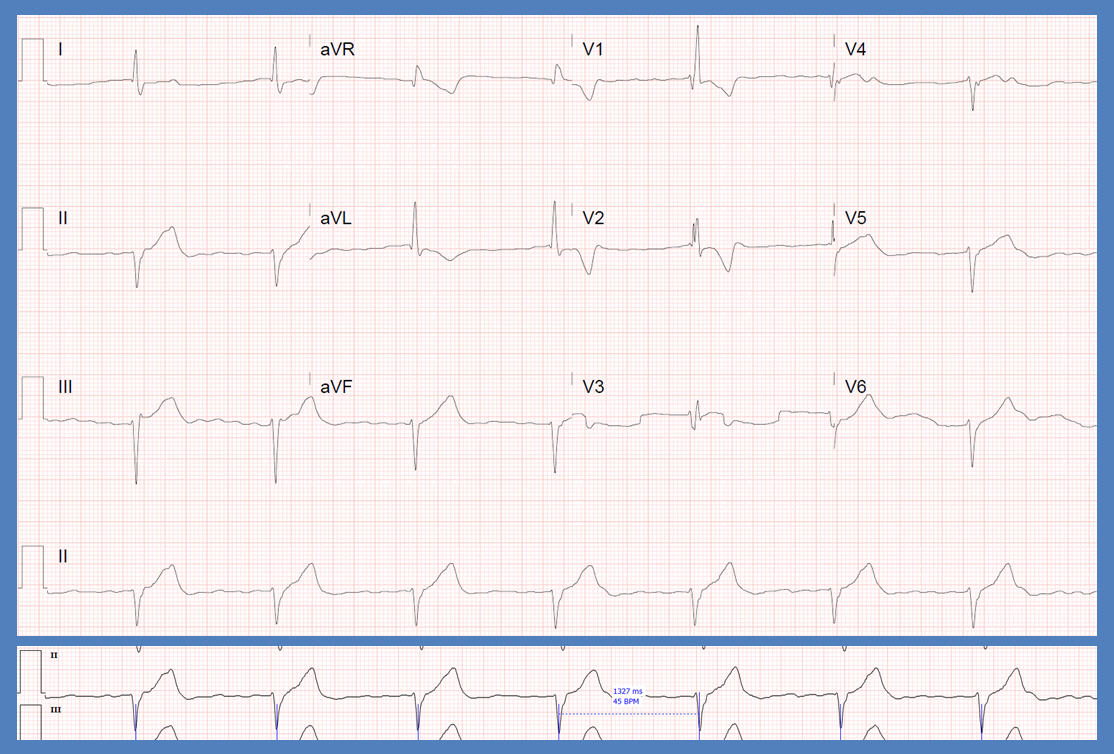April 2024 Issue
ISSN 2689-291X
ISSN 2689-291X
Frederick’s Syndrome:
Atrial Fibrillation with Complete Heart Block!
Description
The above electrocardiogram (ECG) was obtained in an elderly patient with profound acidosis and multiple electrolyte abnormalities post trauma. The baseline atrial rhythm is atrial fibrillation, with no discernible P waves. However, the ventricular rhythm is regular and bradycardic; most likely a junctional escape rhythm at 45 beats per minute (as shown in the insert rhythm strip). There is incomplete right bundle branch block and left anterior fascicular block with anterior ST and T wave abnormalities suggestive of ischemia.
Discussion
Atrial Fibrillation is a very common arrhythmia which can cause tachycardia and bradycardia depending on the extent of atrio-ventricular (AV) conduction. When the ventricular response is markedly slow and regular due to either medication effect or marked intrinsic AV nodal disease, complete AV block with a junctional escape rhythm is presumed [1]. This rhythm often mandates pacing, often specialized pacing, as it may result in serious symptoms and can progress to life-threatening hemodynamic compromise [2].
An eponym of “Frederick’s Syndrome” has been used for this condition [3] based on the description by Leon Frederick, a Belgian physiologist, in 1904 [4]. This condition is associated with left atrial thrombosis, due to the underlying atrial fibrillation causing stasis of blood in the atria [5].
References
The above electrocardiogram (ECG) was obtained in an elderly patient with profound acidosis and multiple electrolyte abnormalities post trauma. The baseline atrial rhythm is atrial fibrillation, with no discernible P waves. However, the ventricular rhythm is regular and bradycardic; most likely a junctional escape rhythm at 45 beats per minute (as shown in the insert rhythm strip). There is incomplete right bundle branch block and left anterior fascicular block with anterior ST and T wave abnormalities suggestive of ischemia.
Discussion
Atrial Fibrillation is a very common arrhythmia which can cause tachycardia and bradycardia depending on the extent of atrio-ventricular (AV) conduction. When the ventricular response is markedly slow and regular due to either medication effect or marked intrinsic AV nodal disease, complete AV block with a junctional escape rhythm is presumed [1]. This rhythm often mandates pacing, often specialized pacing, as it may result in serious symptoms and can progress to life-threatening hemodynamic compromise [2].
An eponym of “Frederick’s Syndrome” has been used for this condition [3] based on the description by Leon Frederick, a Belgian physiologist, in 1904 [4]. This condition is associated with left atrial thrombosis, due to the underlying atrial fibrillation causing stasis of blood in the atria [5].
References
- Yanagisawa Y, Ibrahim W, Kumar N. A case of atrial fibrillation complicated by complete atrioventricular block. SAGE Open Med Case Rep. 2023 Feb 27;11:2050313X231157486.
- Zhang D, Huang X. Treatment of atrial fibrillation with third-degree atrioventricular block by pacing His bundle and left bundle branch: Case report. Medicine (Baltimore). 2020 Aug 14;99(33):e21097.
- Tzur I, Izhakian S, Gorelik O. Frederick’s syndrome: A forgotten eponym. Open J Clin Med Case Rep. 2019; 1603.
- Fredericq L. Rythme affolé des ventricules dû a la fibrillation des oreillettes: physiologie du faisceau auriculo-ventriculaire. Arch Internat Physiol. 1904/1905; 2: 281-285.
- Khorkova NYu, Gizatulina TP, Kolunin GV, Belokurova AV. Left atrial appendage thrombosis and Frederick’s syndrome: a case report. Journal of Arrhythmology. 2022; 2022;29(3): 48-53.
Authors:
Mustafeez Ur Rahman, M.D.
Cardiology Fellow
University of South Alabama
Mobile, AL
Mariam Riad, M.D.
Cardiology Fellow
University of South Alabama
Mobile, AL
Nupur Shah, M.D.
Cardiology Fellow
University of South Alabama
Mobile, AL
Brent Ruiz, M.D.
Cardiology Fellow
University of South Alabama
Mobile, AL
Hajira Malik, M.D.
Cardiology Fellow
University of South Alabama
Mobile, AL
Celestine Odigwe, M.D.
Cardiology Fellow
University of South Alabama
Mobile, AL
Rajasekhar Mulyala, M.D.
Cardiology Fellow
University of South Alabama
Mobile, AL
Bassam Omar, M.D., Ph.D.
Professor of Cardiology
University of South Alabama
Mobile, AL
Christopher Malozzi, D.O.
Associate Professor of Cardiology
University of South Alabama
Mobile, AL
Mustafeez Ur Rahman, M.D.
Cardiology Fellow
University of South Alabama
Mobile, AL
Mariam Riad, M.D.
Cardiology Fellow
University of South Alabama
Mobile, AL
Nupur Shah, M.D.
Cardiology Fellow
University of South Alabama
Mobile, AL
Brent Ruiz, M.D.
Cardiology Fellow
University of South Alabama
Mobile, AL
Hajira Malik, M.D.
Cardiology Fellow
University of South Alabama
Mobile, AL
Celestine Odigwe, M.D.
Cardiology Fellow
University of South Alabama
Mobile, AL
Rajasekhar Mulyala, M.D.
Cardiology Fellow
University of South Alabama
Mobile, AL
Bassam Omar, M.D., Ph.D.
Professor of Cardiology
University of South Alabama
Mobile, AL
Christopher Malozzi, D.O.
Associate Professor of Cardiology
University of South Alabama
Mobile, AL

